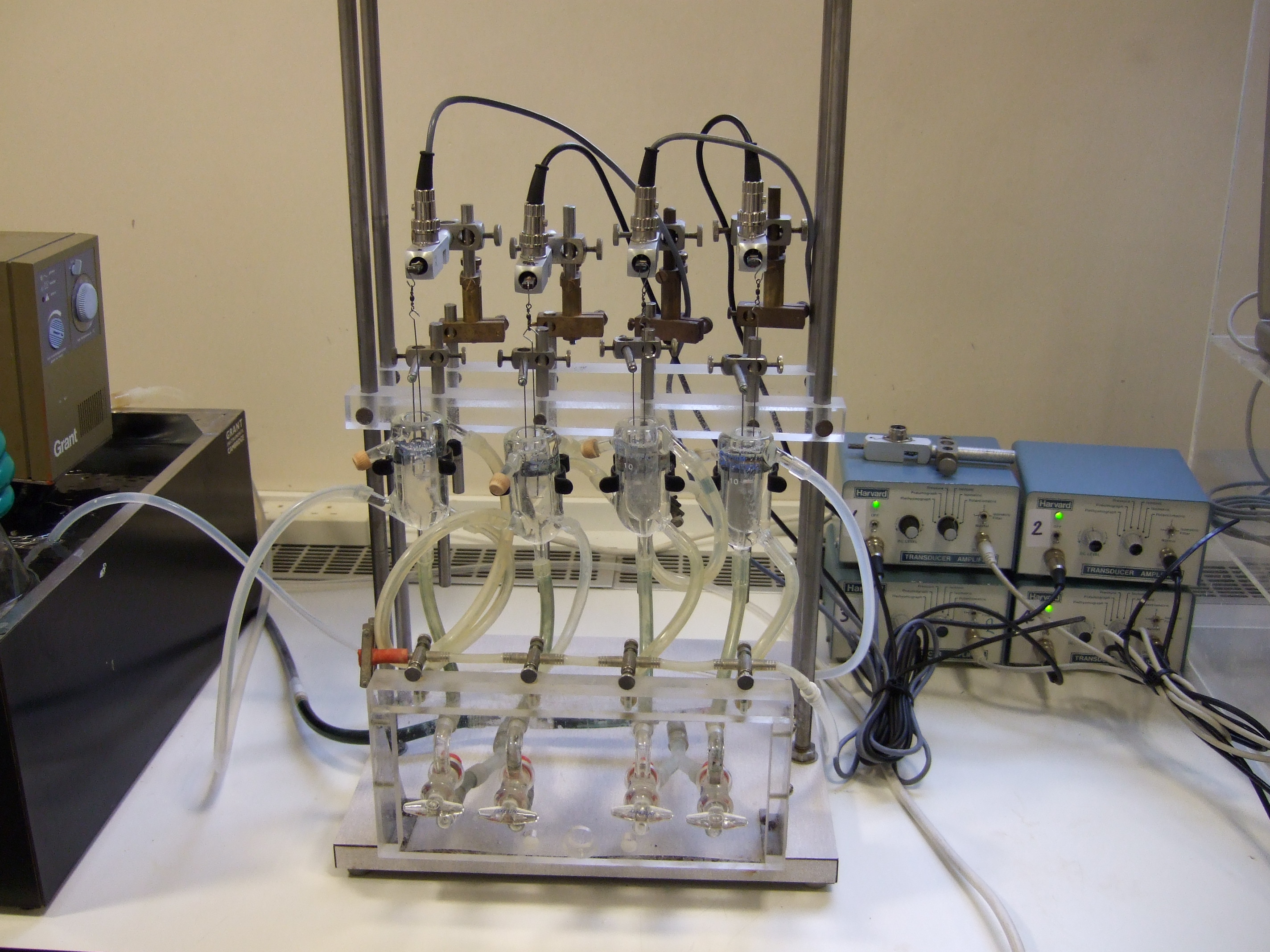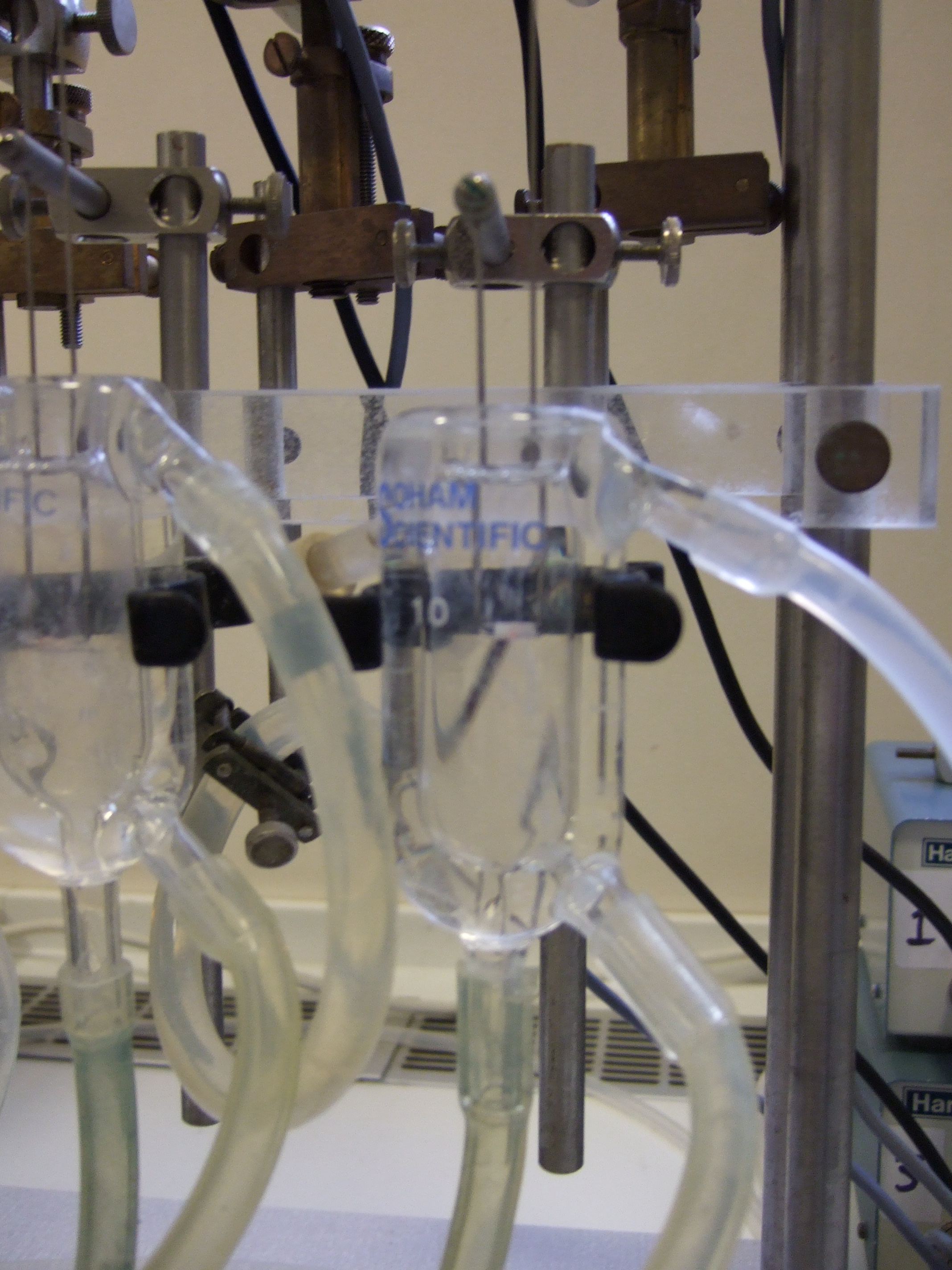Ben - Hello! I'm here in the Department of Pharmacology with Brian Callingham. What are you going to show us today Brian?
Brian - I'd like to show you how arteries work.

Ben - Work in what sense?
Brian - Work in the way in which they respond to drugs in particular, both for good and for ill.
Ben - So how do arteries generally respond?
Brian - They respond either by contracting or by relaxing. They have to control the blood supply to various organs and tissues of the body. A good example is that in cold weather you want the blood vessels in your skin to constrict so that you don't lose heat. Conversely in the summer you would like them to relax and dilate so that you can get rid of heat.
Ben - This equipment is quite scary looking, you might expect to see it in a mad scientists lab; there's glass, there's tubes, there's bubbling, there's metal; what is it all for?
Brian - The vessels you're looking at, called organ baths, are about three inches high and about ¾ of an inch in diameter and contain a nutrient solution. If you look closely you can find there's a small ring of a piece of the digital artery of the deer, that we obtain from the abattoir. We measure the tension that it develops by putting a wire loop through the lumen, and attaching the loop to a transducer. This transducer measures the force developed by the little muscles in the wall of the blood vessel. The signal is then passed on via an amplifier to be recorded by a computer.
What I would like to show you is the effect of some chemicals that we can add to these segments of blood vessel in the organ baths. One is the action of Nor-adrenaline, which is the body's natural stress hormone and involved in the responses of blood vessels when you've received a nasty fright or got angry.
Ben - Brian is using a pipette to add a few drops, only a tiny amount, into the organ bath. Looking at the laptop the graphs at the moment have flat lines, what does that mean?
Brian - That's the resting tension of the arteries before the drug has taken effect...
Ben - Sorry to interrupt, but that's amazing, it's just shot up by at least three times the level it was on, what's happening here?

Brian - Well the drug is now having it's effect and causing a very substantial contraction of the circular muscle of the artery.
Ben - Is this the same thing that happens in our own arteries when it's cold?
Brian - Oh yes, what you're seeing here is intense constriction of the arteries, which in us would, of course, reduce the blood flow and thus reduce heat loss.
Ben - So what sort of pressures are you recording? What sort of force is that?
Brian - The force on these little pieces of muscle probably corresponds to about the weight of an AA battery dangling from this little tiny piece of vessel.
Ben - So now that we've made them constrict, is there any way to open them up again?
Brian - Oh yes, there are several ways of doing that. One way, which I would like to show you now, is to use a drug which mimics the action of the drug glyceryl tri-nitrate, which is used for the relief of the terrible pain of angina, when people have cardiovascular disease. So we'll go back to the organ baths now and I will add a similar amount of the drug to the organ bath, lets see what happens.
Ben - Brian's added the other drug now, we're still looking at the same graph, which is still very high. Now, however, it's shooting down, and it really is dropping quite quickly, showing that the artery is opening up again and relaxing.
Brian - This has caused the vessel to relax, which would cause it to open up again blood flow would then go back to normal.
Ben - So how is that useful in the human body?
Brian - The response we've just seen illustrates how these drugs would work in the body for the relief of the pain of angina. The problem with angina is that the heart is deprived of oxygen, very largely as the result of failure of the coronary blood supply, and the pain that it generates is terrible. You want something that works very quickly, as we've seen here. It works very largely by being taken through the blood supply, where it interacts in the endothelium to cause the release of nitric oxide. This nitric oxide then stimulates the processes in the muscle to cause it to relax. As a result of that, you then decrease the work on the heart, it needs less oxygen, and the pain hopefully goes away.
- Previous Electric Slime
- Next Build a Hot Air Balloon









Comments
Add a comment